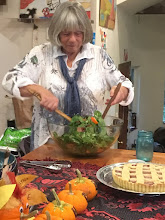Although some people disparage Thanksgiving as a gluttonous and gormandizing occasion, it seems almost frugal in light of historical feasts. The Romans, for instance, especially in the latter days of the empire, were infamous for their lavish spreads. At one ceremonial occasion, which Julius Caesar attended, the first course consisted of sea urchins, unlimited raw oysters, scallops, cockles, thrushes on asparagus, fattened fowls, and corn fish (both black and white). Then came cockles, mussels, sea nettles, figpeckers, haunches of venison and boar, fattened fowls cooked in pastry, more figpeckers, murex, and purple fish. After that came the main dishes: sow's udders, ducks, boiled teal, hares, roasted fowls, creamed wheat, and rolls. The emperor Elagabalus served his guests sausages, made from mollusks, prawns, oysters, squid, and crab, as well as camels' feet, the combs from live chicken, tongues of peacocks and nightingales, mullets' livers, the brains of flamingos and thrushes, and the heads of parrots, pheasants, and peacocks. Our dinner of turkey, dressing, potatoes, cranberry sauce, and pie seems paltry and mundane in comparison.
We usually go to some trouble to set a grand table—linen tablecloth and napkins, napkin rings, the best silverware and serving dishes, the good china, crystal wine glasses. But during late Renaissance in Europe, tables were laid with several layers of tablecloths, each to be lifted in turn as new courses were brought in. Napkins were folded in complex shapes, such as flames, birds, columns, arches, trophies. At a banquet in honor of Giuliano and Lorenzo de Medici, each napkin enclosed a little bird, which flew way when the guest opened the folds. At one nuptials banquet in Brussels, the napkins were folded by famed napkin-folder Giovanni Milanese, who pleated the napkins to represent two castles compete with artillery, infantry and artificial fire in recognition of the royal groom's military career. The best sculptors were commissioned to make salt cellars and elaborate sculptural concoctions of sugar, such as those designed by Dorat for a banquet in Paris, depicting—in sugar, remember—the history of the goddess Minerva. At court, the most coveted jobs were those of the carver and of him who unfolded the king's napkin and laid it in his lap.
We might decorate the Thanksgiving table with autumn leaves and tiny pumpkins, but entertainment is usually simply conversation—oh, and football on TV, of course. Renaissance banquets, on the other hand, became theatrical events in themselves, involving masques, processions, and allegories. At the Brussels banquet I just mentioned a masque was performed by "eight aristocratic children escorted by musicians and torchbearers" that ended with the presentation of posies of artificial flowers. Then the tables were cleared for the ball.
Such elaborate dinners are but pictures in history now not even mimicked by royalty or heads of state, and we in our homes share far simpler feasts. The emphasis of our harvest celebration banquet is not on theater or decoration but on the food. To my way of thinking, that's where it should be.
Next week: "Emma Lou's Fried Apple Pies"
Next week: "Emma Lou's Fried Apple Pies"

No comments:
Post a Comment